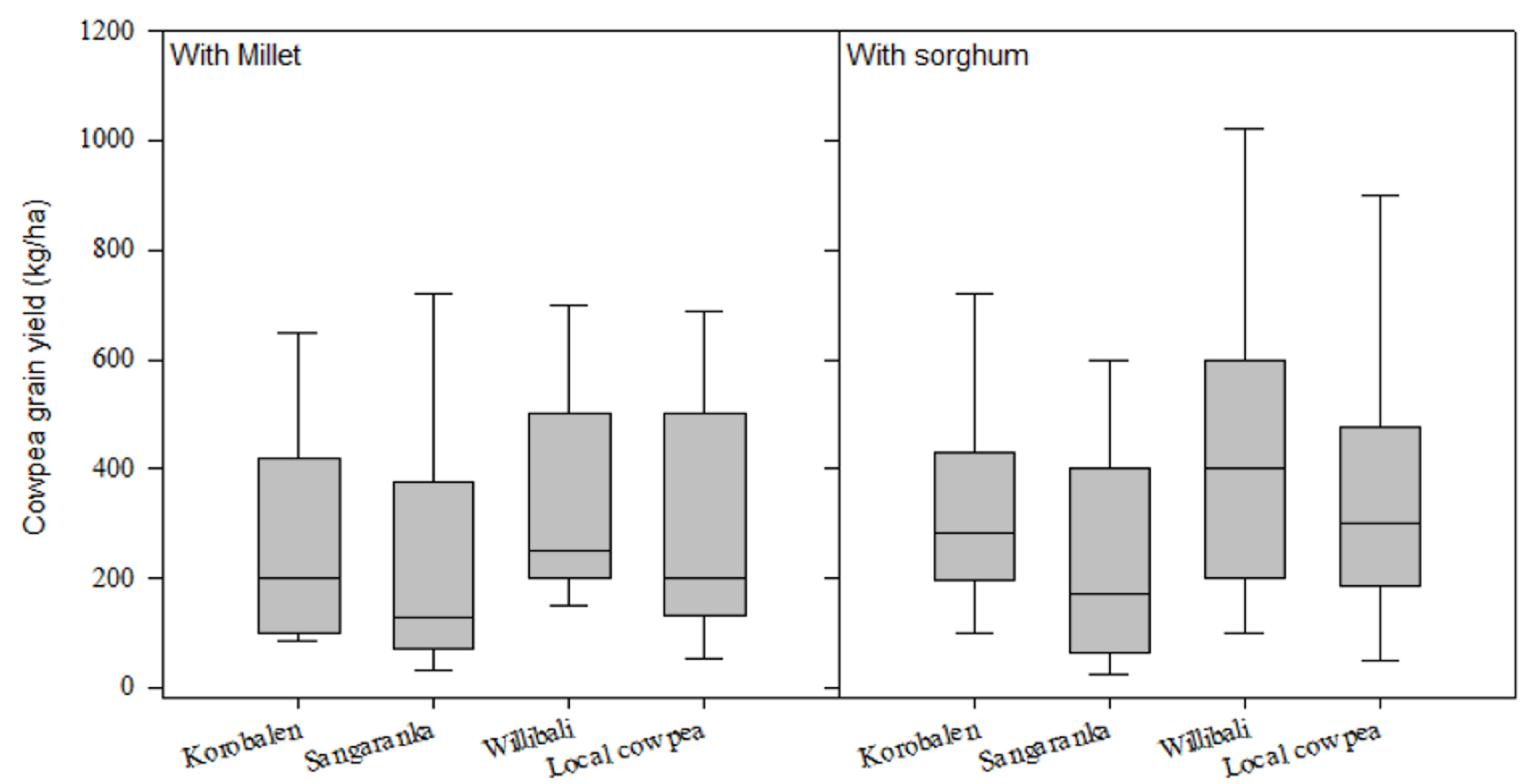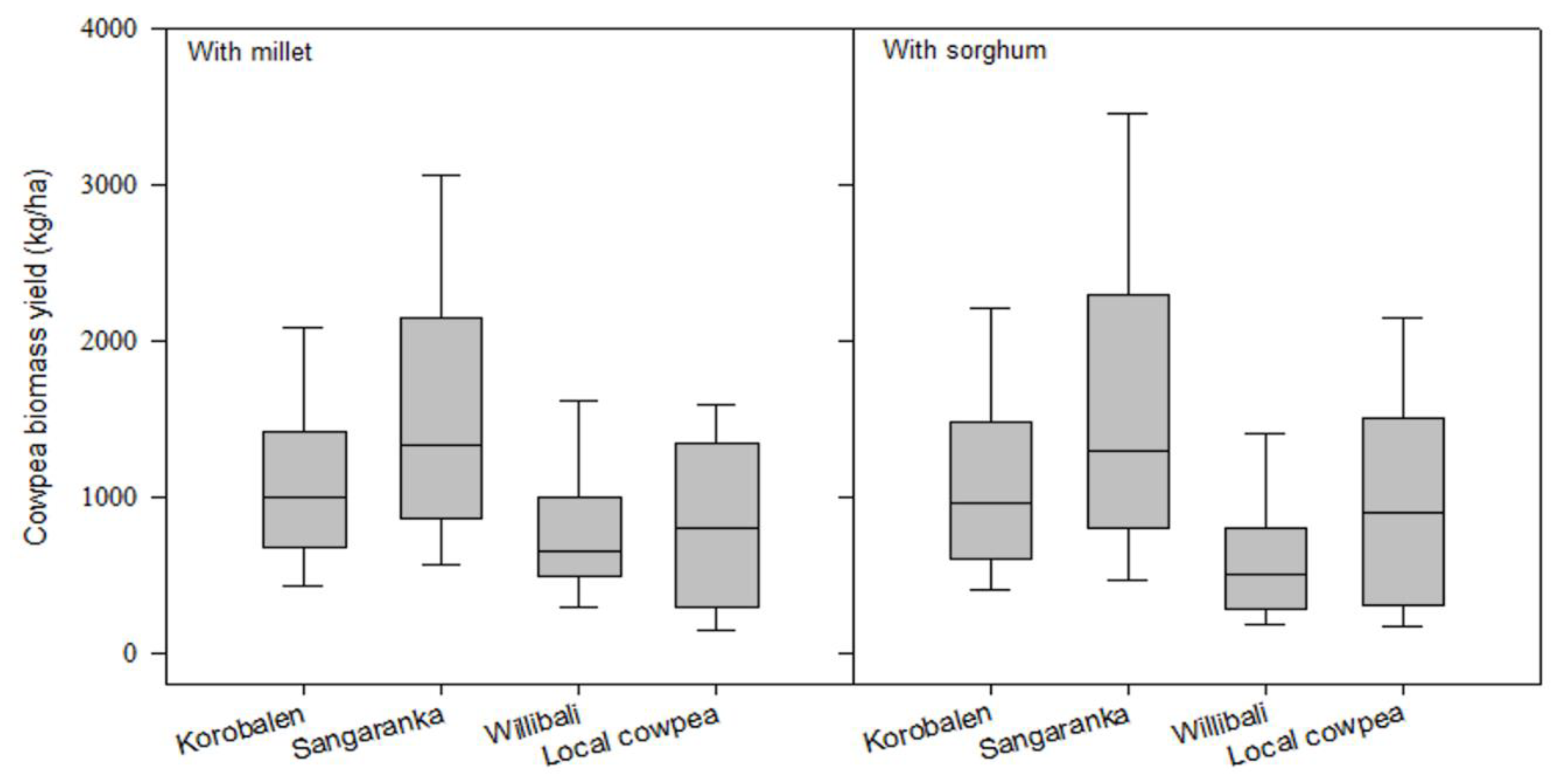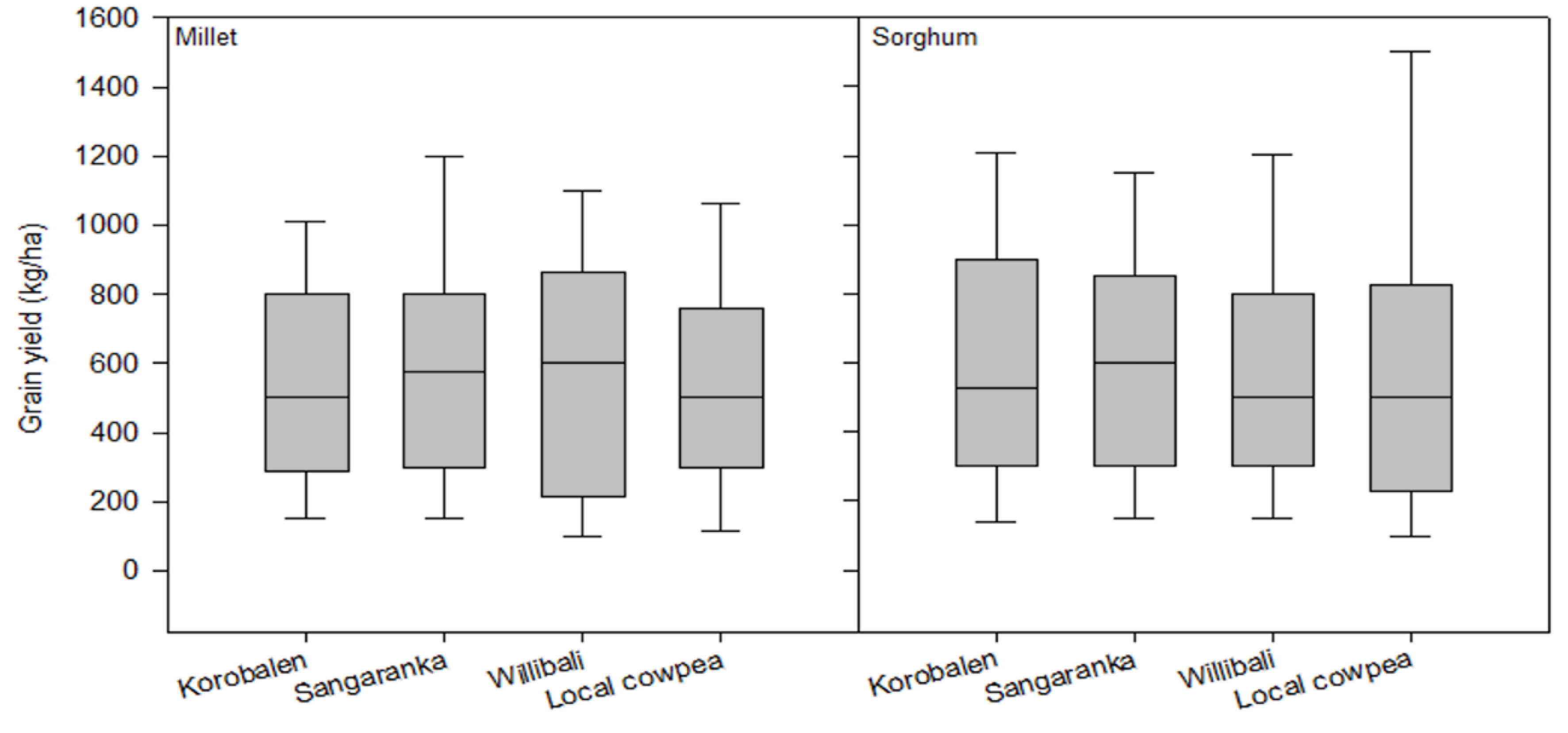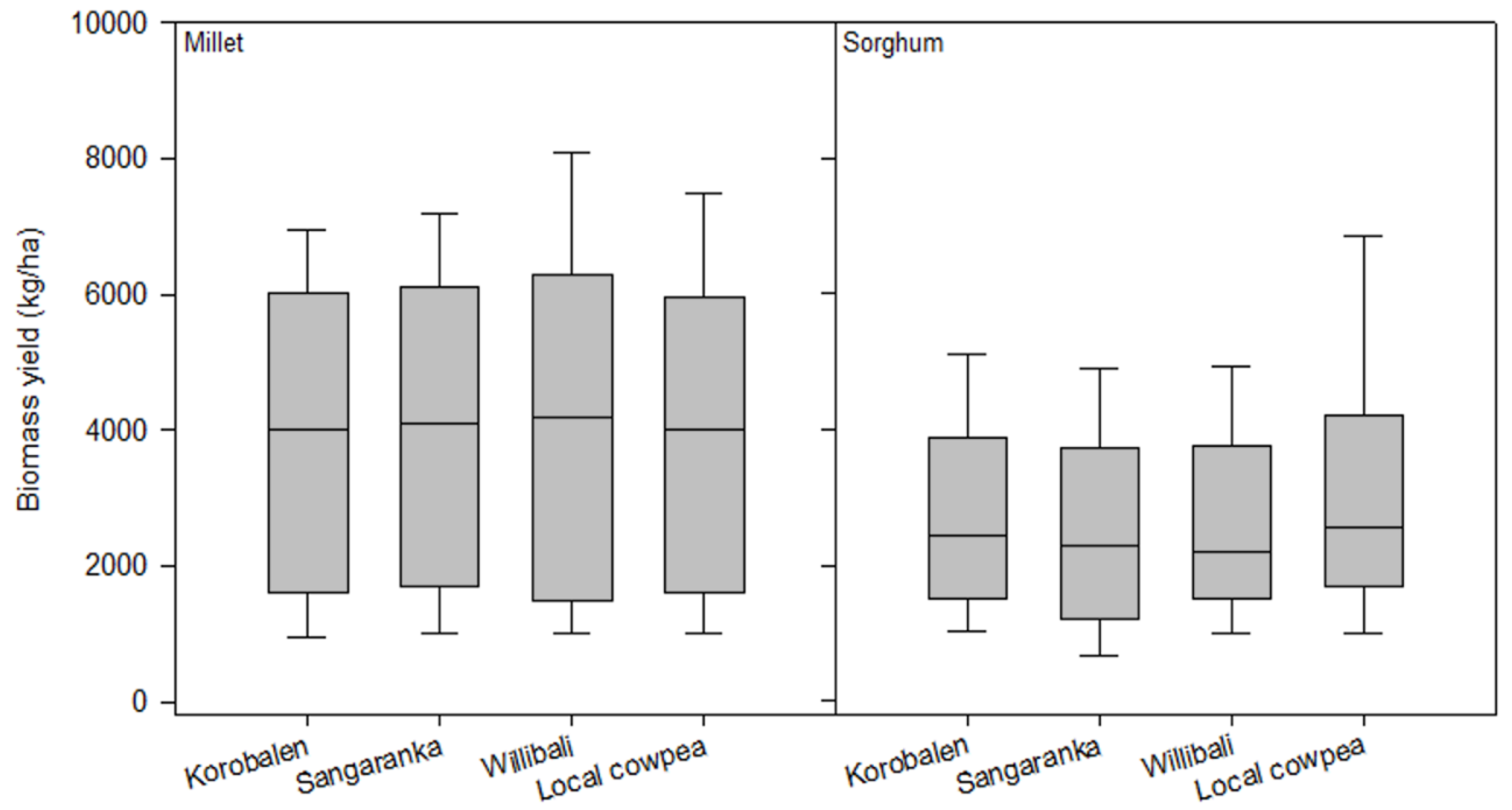On-Farm Evaluation on Yield and Economic Performance of Cereal-Cowpea Intercropping to Support the Smallholder Farming System in the Soudano-Sahelian Zone of Mali
Abstract
:1. Introduction
2. Materials and Methods
2.1. Study Area
2.2. Field Experimentation
2.3. Measurement
2.4. Statistical Analysis
2.4.1. System Gain
2.4.2. Farmers’ Ranking of Cowpea Varieties
3. Results
3.1. Yield of Grain and Biomass of Cowpea under Intercropping with Millet and Sorghum
3.2. Grain and Biomass Yield of Millet and Sorghum under Intercropping with Cowpea Varieties
3.3. Effect of Crop Rotation on Intercropping
3.4. Economic Gains
3.4.1. Gains with Cowpea Grain and Biomass under Intercropping with Millet and Sorghum
3.4.2. Gain with Millet and Sorghum in Intercropping with Cowpea
3.4.3. Total Economic Gain per System
4. Discussion
4.1. Yield Variation under Intercropping with Cereal
4.2. Cowpea Varieties under Intercropping
4.3. Cereal-Cowpea Rotation
4.4. Economic Performance of the Cereal-Cowpea System and Farmers’ Perceptions
5. Conclusions
Author Contributions
Funding
Acknowledgments
Conflicts of Interest
References
- FAO. Corporate Statistical Database (FAOSTAT), 2018; FAO: Rome, Italy, 2019. [Google Scholar]
- Shewry, P.R. Advances in Sorghum and Millet Research Special Issue. J. Cereal Sci. 2019, 85, A1. [Google Scholar] [CrossRef]
- Sanogo, O.M. Participatory Evaluation of the Dairy Cow Supplementation Technologies in a Country Setting at Mali (Koutiala)/ Évaluation Participative Des Technologies de Supplementation Des Vaches Laitières En Milieu Paysan Au Mali (Koutiala). Can. J. Dev. Stud. 2010, 31, 91–106. [Google Scholar] [CrossRef]
- FAO. West African Catalogue of Plant Species and Varieties; FAO: Rome, Italy, 2008. [Google Scholar]
- Traore, B.; Corbeels, M.; van Wijk, M.T.; Rufino, M.C.; Giller, K.E. Effects of Climate Variability and Climate Change on Crop Production in Southern Mali. Eur. J. Agron. 2013, 49. [Google Scholar] [CrossRef]
- Jones, A.; Breuning-Madsen, H.; Brossard, M.; Dampha, A.; Deckers, J.; Dewitte, O.; Gallali, T.; Hallett, S.; Jones, R.; Kilasara, M. Soil Atlas of Africa. Luxembourg. Publ. Off. Eur. Union 2013. Available online: https://op.europa.eu/en/publication-detail/-/publication/f57a0bdf-94d1-11e5-983e-01aa75ed71a1 (accessed on 9 June 2020).
- Giller, K.E.; Tittonell, P.; Rufino, M.C.; van Wijk, M.T.; Zingore, S.; Mapfumo, P.; Adjei-Nsiah, S.; Herrero, M.; Chikowo, R.; Corbeels, M.; et al. Communicating Complexity: Integrated Assessment of Trade-Offs Concerning Soil Fertility Management within African Farming Systems to Support Innovation and Development. Agric. Syst. 2011, 104, 191–203. [Google Scholar] [CrossRef]
- Falconnier, G.N.; Descheemaeker, K.; Van Mourik, T.A. Understanding Farm Trajectories and Development Pathways: Two Decades of Change in Southern Mali Understanding Farm Trajectories and Development Pathways: Two Decades of Change in Southern Mali. F. Crop. Res. 2015. [Google Scholar] [CrossRef]
- Zougmoré, R.; Partey, S.; Ouédraogo, M.; Omitoyin, B.; Thomas, T.; Ayantunde, A.; Ericksen, P.; Said, M.; Jalloh, A. Toward Climate-Smart Agriculture in West Africa: A Review of Climate Change Impacts, Adaptation Strategies and Policy Developments for the Livestock, Fishery and Crop Production Sectors. Agric. Food Secur. 2016, 5, 26. [Google Scholar] [CrossRef]
- Challinor, A.; Wheeler, T.; Garforth, C.; Craufurd, P.; Kassam, A. Assessing the Vulnerability of Food Crop Systems in Africa to Climate Change. Clim. Chang. 2007, 83, 381–399. [Google Scholar] [CrossRef]
- Rusinamhodzi, L.; Corbeels, M.; Nyamangara, J.; Giller, K.E. Maize–Grain Legume Intercropping Is an Attractive Option for Ecological Intensification That Reduces Climatic Risk for Smallholder Farmers in Central Mozambique. F. Crop. Res. 2012, 136, 12–22. [Google Scholar] [CrossRef] [Green Version]
- Ayantunde, A.A.; Turner, M.D.; Kalilou, A. Participatory Analysis of Vulnerability to Drought in Three Agro-Pastoral Communities in the West African Sahel. Pastoralism 2015, 5. [Google Scholar] [CrossRef] [Green Version]
- Kamara, A.Y.; Omoigui, L.O.; Kamai, N.; Ewansiha, S.U.; Ajeigbe, H.A. Improving Cultivation of Cowpea in West Africa; Burleigh Dodds Science Publishing: Cambridgeshire, UK, 2018. [Google Scholar]
- Lithourgidis, A.S.; Dordas, C.A.; Damalas, C.A.; Vlachostergios, D.N. Annual Intercrops: An Alternative Pathway for Sustainable Agriculture. Aust. J. Crop Sci. 2011, 5, 396–410. [Google Scholar]
- Falconnier, G.N.; Descheemaeker, K.; Mourik, T.A.V.; Giller, K.E. Unravelling the Causes of Variability in Crop Yields and Treatment Responses for Better Tailoring of Options for Sustainable Intensification in Southern Mali. F. Crop. Res. 2016, 187, 113–126. [Google Scholar] [CrossRef] [Green Version]
- Traore, B.; van Wijk, M.T.; Descheemaeker, K.; Corbeels, M.; Rufino, M.C.; Giller, K.E. Evaluation of Climate Adaptation Options for Sudano-Sahelian Cropping Systems. F. Crop. Res. 2014, 156, 63–75. [Google Scholar] [CrossRef]
- Takim, F.O. Advantages of Maize-Cowpea Intercropping over Sole Cropping through Competition Indices. J. Agric. Biodivers. Res. 2012, 1, 53–59. [Google Scholar]
- Maman, N.; Dicko, M.; Abdou, G.; Kouyate, Z.; Wortmann, C. Pearl Millet and Cowpea Intercrop Response to Applied Nutrients in West Africa. Agron. J. 2017, 109, 2333–2342. [Google Scholar] [CrossRef] [Green Version]
- Instat. Annuaire Statistique Du Mali 2018; Instat: Bamako, Mali, 2018. [Google Scholar]
- Hazelton, P.; Murphy, B. Interpreting Soil Test Results: What Do All the Number Means? CSIRO Publishing: Collingwood, VIC, Australia, 2007. [Google Scholar]
- Vanlauwe, B.; Descheemaeker, K.; Giller, K.E.; Huising, J.; Merckx, R. Integrated Soil Fertility Management in Sub-Saharan Africa: Unravelling Local Adaptation. SOIL Discuss. 2014, 1239–1286. [Google Scholar] [CrossRef] [Green Version]
- Abdoulaye, T.; Sanders, J.H. Stages and Determinants of Fertilizer Use in Semiarid African Agriculture: The Niger Experience. In Agricultural Economics; Blackwell Publishing Inc.: Malden, MA, USA, 2005; Volume 32, pp. 167–179. [Google Scholar]
- Uddin, R.O., II; Abdulazeez, R.W. Comparative Efficacy of Neem (Azadirachta Indica), False Sesame (Ceratotheca Sesamoides) Endl. and the Physic Nut (Jatropha Curcas) in the Protection of Stored Cowpea (Vigna Unguiculata) L. Walp against the Seed Beetle Callosobruchus Maculatus (F.). Ethiop. J. Environ. Stud. Manag. 2013, 6, 827–834. [Google Scholar] [CrossRef] [Green Version]
- Ajeigbe, H.A.; Singh, B.B.; Adeosun, J.O.; Ezeaku, I.E. Participatory On-Farm Evaluation of Improved Legume-Cereals Cropping Systems for Crop-Livestock Farmers: Maize-Double Cowpea in Northern Guinea Savanna Zone of Nigeria. Afr. J. Agric. Res. 2010, 5, 2080–2088. [Google Scholar]
- Adu-Gyamfi, J.J.; Aigner, M.; Gludovacz, D. Variations in Phosphorus Acquisition from Sparingly Soluble Forms by Maize and Soybean in Low-and Medium-P Soils Using P-32. Proc. Int. Plant Nutr. Colloquium XVI 2009, 1008–1016. [Google Scholar]
- Cuny, P.; Sorg, J.-P. Forêt et Coton Au Sud Du Mali: Cas de La Commune Rurale de Sorobasso. BOIS FORETS DES Trop. 2003, 276, 17–31. [Google Scholar]
- Turner, M.D.; Ayantunde, A.A.; Patterson, K.P.; Patterson, E.D., III. Livelihood Transitions and the Changing Nature of Farmer–Herder Conflict in Sahelian West Africa. J. Dev. Stud. 2011, 47, 183–206. [Google Scholar] [CrossRef]
- Trail, P.; Abaye, O.; Thomason, W.E.; Thompson, T.L.; Gueye, F.; Diedhiou, I.; Diatta, M.B.; Faye, A. Evaluating Intercropping (Living Cover) and Mulching (Desiccated Cover) Practices for Increasing Millet Yields in Senegal. Agron. J. 2016, 108, 1742–1752. [Google Scholar] [CrossRef]
- Sissoko, F.; Affholder, F.; Autfray, P.; Wery, J.; Rapidel, B. Wet Years and Farmers’ Practices May Offset the Benefits of Residue Retention on Runoff and Yield in Cotton Fields in the Sudan–Sahelian Zone. Agric. Water Manag. 2013, 119, 89–99. [Google Scholar] [CrossRef]
- Rusinamhodzi, L.; Makumbi, D.; Njeru, J.M.; Kanampiu, F. Performance of Elite Maize Genotypes under Selected Sustainable Intensification Options in Kenya. F. Crop. Res. 2020, 249, 107738. [Google Scholar] [CrossRef] [PubMed]
- Blanchard, M.; Coulibaly, K.; Bognini, S.; Dugue, P.; Eric, V. Diversity in the Quality of Organic Manure Produced on Farms in West Africa: What Impact on Recommendations for the Use of Manure? Biotechnol. Agron. Soc. Environ. 2014, 18, 512–523. [Google Scholar]
- Bationo, A.; Ntare, B.R. Rotation and Nitrogen Fertilizer Effects on Pearl Millet, Cowpea and Groundnut Yield and Soil Chemical Properties in a Sandy Soil in the Semi-Arid Tropics, West Africa. J. Agric. Sci. 2000, 134, 277–284. [Google Scholar] [CrossRef] [Green Version]
- Alvey, S.; Bagayoko, M.; Neumann, G.; Buerkert, A. Cereal/Legume Rotations Affect Chemical Properties and Biological Activities in Two West African Soils. Plant Soil 2001, 231, 45–54. [Google Scholar] [CrossRef]
- De la Croix, D. L’agriculture Familiale Des Zones Cotonnières d’Afrique de l’ouest: Le Cas Du Mali; AFD: Paris, France, 2004. [Google Scholar]
- Ripoche, A.; Crétenet, M.; Corbeels, M.; Affholder, F.; Naudin, K.; Sissoko, F.; Douzet, J.M.; Tittonell, P. Cotton as an Entry Point for Soil Fertility Maintenance and Food Crop Productivity in Savannah Agroecosystems-Evidence from a Long-Term Experiment in Southern Mali. F. Crop. Res. 2015, 177, 37–48. [Google Scholar] [CrossRef]
- Ibrahim, A.; Abaidoo, R.C.; Fatondji, D.; Opoku, A. Fertilizer Micro-Dosing Increases Crop Yield in the Sahelian Low-Input Cropping System: A Success with a Shadow. Soil Sci. Plant Nutr. 2016, 62, 277–288. [Google Scholar] [CrossRef] [Green Version]
- RESIMAO. Bulletin Mensuel Sur Les Marches Agricoles; Mai 2017-N°009; RESIMAO: Madina, Saudi Arabia, 2017. [Google Scholar]
- Mohammed, U.S.; Mohammed, F.K. Profitability Analysis of Cowpea Production in Rural Areas of Zaria Local Government Area of Kaduna State, Nigeria. Int. J. Dev. Sustain. 2014, 3, 1919–1926. [Google Scholar]
- Dunkel, F.V. Incorporating Cultures’ Role in the Food and Agricultural Sciences; Academic Press: Cambridge, MA, USA, 2017. [Google Scholar]




| Crop | Variety | Time to Maturity (days) | Duration |
|---|---|---|---|
| Cowpea | Wilibali | 60–65 | Short |
| Cowpea | Korobalen | 70–75 | Medium |
| Cowpea | Sangaranka | 90–100 | Long |
| Cowpea | Local | 60–70 and 90–100 | Short and long |
| Sorghum | Jakumbè (CSM63E) | 90–100 | Medium |
| Millet | Toroniou | 90–100 | Medium |
| Crop | Year | Planting Date | 1st Weeding (DAP) | 2nd Weeding (DAP) | Fertilizer Application (DAP) | Biopesticide Treatment 1 (DAP) | Biopesticide Treatment 2 (DAP) |
|---|---|---|---|---|---|---|---|
| Millet | 2016 | 12/07 ± 8.2 | 19.0 ± 6.6 | 34.3 ± 7.9 | 21.9 ± 5.7 | 36.0 ± 6 | 53.8 ± 15 |
| Sorghum | 15/07 ± 6.7 | 19 ± 10.6 | 35.83 ± 13.5 | 21.56 ± 9.5 | 46.30 ± 18.7 | 58.00 ± 22 | |
| Millet | 2017 | 13/07 ± 7.3 | 18.0 ± 6.4 | 35.5 ± 8.4 | 18.3 ± 6.8 | 35.4 ± 10.6 | 49.7 ± 9.6 |
| Sorghum | 12/07 ± 6 | 17.8 ± 12.6 | 34.54 ± 12.3 | 16.34 ± 5.8 | 40.60 ± 19.1 | 55.88 ± 19.2 |
| Cowpea Yield with Millet Intercropping | Cowpea Yield with Sorghum Intercropping | |||||||
|---|---|---|---|---|---|---|---|---|
| DF | Grain | DF | Biomass | DF | Grain | DF | Biomass | |
| Village | 36 | - | 39 | - | 38 | - | 38 | - |
| Cowpea variety | 3 | - | 3 | - | 3 | - | 3 | - |
| Korobalen | 310.3 | 1154 | 382.6 | 1125 | ||||
| Sangarakan | 261.1 | 1637 | 253.2 | 1592 | ||||
| Wilibali | 417.6 | 815 | 475.5 | 659 | ||||
| Local cowpea | 317.2 | 913 | 386.1 | 1012 | ||||
| v.r | 2.69 | 13.58 | 4.38 | 17.78 | ||||
| p-value | 0.04 | 0.001 | 0.003 | 0.001 | ||||
| SED | 54.53 | 140.6 | 66.79 | 126.9 | ||||
| Year 2016 | 1 | 337.9 | 1171 | 1 | 416.8 | 1212 | ||
| Year 2017 | 319.5 | 1068 | 331.9 | 964 | ||||
| P-value Year | 0.79 | 0.57 | 0.22 | 0.10 | ||||
| Interaction of cowpea and Year | 3 | 0.78 | 0.95 | 3 | 0.23 | 0.51 | ||
| p-value cowpea grain vs. biomass | 0.001 | 0.001 | ||||||
| Millet Yield with Cowpea Intercropping | Sorghum Yield with Cowpea Intercropping | |||||||
|---|---|---|---|---|---|---|---|---|
| DF | Grain | DF | Biomass | DF | Grain | DF | Biomass | |
| Village | 37 | - | 31 | - | 37 | - | 37 | - |
| Cowpea variety | 3 | - | 3 | - | 3 | - | 3 | - |
| Korobalen | 561.5 | 3916 | 616.7 | 2793 | ||||
| Sangarakan | 612.9 | 4061 | 638.8 | 2821 | ||||
| Wilibali | 596.5 | 4117 | 617.3 | 2773 | ||||
| Local cowpea | 538.9 | 4040 | 612 | 3308 | ||||
| v.r | 1.33 | 0.28 | 0.09 | 3.02 | ||||
| p-value | 0.27 | 0.84 | 0.96 | 0.03 | ||||
| SED | 40.98 | 228 | 57.01 | 206 | ||||
| Year 2016 | 1 | 635.7 | 5415 | 1 | 632.9 | 4298 | ||
| Year 2017 | 511.5 | 2795 | 610.3 | 1563 | ||||
| p-value Year | 0.01 | 0.001 | 0.75 | 0.001 | ||||
| Interaction of crop and Year | 3 | 0.37 | 0.44 | 3 | 0.64 | 0.678 | ||
| p-value grain vs. biomass | 0.001 | 0.001 | ||||||
| Rotation | Millet Yield from Intercropping with Cowpea | Sorghum Yield from Intercropping with Cowpea | ||
|---|---|---|---|---|
| Grain | Biomass | Grain | Biomass | |
| Cereal-Cereal | 529.3 | 4808 | 448 | 2445 |
| Cereal-Legume | 624.8 | 5359 | 694.6 | 2871 |
| Coton-Cereal | 588.1 | 6470 | 711.9 | 3689 |
| P-value | 0.227 | 0.001 | 0.001 | 0.001 |
| SED | 72.69 | 504.5 | 82.18 | 335.3 |
| Cowpea Gain with Millet Intercropping | Cowpea Gain with Sorghum Intercropping | |||||||
|---|---|---|---|---|---|---|---|---|
| DF | Grain | DF | Biomass | DF | Grain | DF | Biomass | |
| Village | 36 | - | 39 | - | 38 | - | 38 | - |
| Cowpea variety | 3 | - | 3 | - | 3 | - | 3 | - |
| Korobalen | 93,085 | 201,908 | 114,782 | 196,880 | ||||
| Sangarankan | 78,341 | 286,526 | 75,972 | 278,516 | ||||
| Wilibali | 125,282 | 142,559 | 142,640 | 115,284 | ||||
| Local cowpea | 95,160 | 159,726 | 115,821 | 177,179 | ||||
| v.r. | 2.69 | 13.58 | 4.38 | 17.78 | ||||
| p-value | 0.04 | 0.001 | 0.005 | 0.001 | ||||
| SED | 16,683 | 24,851 | 20,038 | 21,658 | ||||
| Year 1 | 1 | 101,371 | 1 | 204,889 | 1 | 125,027 | 1 | 212,039 |
| Year 2 | 95,839 | 186,971 | 99,561 | 168,648 | ||||
| p-value year | 0.79 | 0.58 | 0.22 | 0.10 | ||||
| Interaction of cowpea and Year | 3 | 0.78 | 3 | 0.62 | 3 | 0.23 | 3 | 0.51 |
| p-value grain vs. biomass | 0.001 | 0.001 | ||||||
| p-value inter. grain and biomass cowpea variety | 0.001 | 0.001 | ||||||
| Millet Gain/ha under Intercropping with Cowpea | Sorghum Gain/ha under Intercropping with Cowpea | |||||||
|---|---|---|---|---|---|---|---|---|
| DF | Grain | DF | Biomass | DF | Grain | DF | Biomass | |
| Village | 37 | - | 24 | - | 37 | - | 37 | - |
| Cowpea variety | 3 | - | 3 | - | 3 | - | 3 | - |
| Korobalen | 88,874 | 301,989 | 96,825 | 349,087 | ||||
| Sangarankan | 96,490 | 299,626 | 100,286 | 352,600 | ||||
| Wilibali | 94,299 | 276,184 | 96,923 | 346,667 | ||||
| Local cowpea | 85,150 | 286,654 | 96,092 | 413,483 | ||||
| v.r | 1.28 | 0.40 | 0.09 | 3.02 | ||||
| p-value | 0.28 | 0.75 | 0.96 | 0.03 | ||||
| SED | 6503 | 25,811 | 8951 | 25,806 | ||||
| Year 2016 | 1 | 100,419 | 263,817 | 1 | 99,367 | 1 | 537,295 | |
| Year 2017 | 80,832 | 297,775 | 95,814 | 195,343 | ||||
| p-value year | 0.02 | 0.78 | 0.75 | 0.001 | ||||
| Interaction of cowpea and Year | 3 | 0.34 | 3 | 0.08 | 3 | 0.64 | 3 | 0.67 |
| p-value grain vs. biomass | 0.001 | 0.001 | ||||||
| DF | Total Gain/ha (Millet and Cowpea) | DF | Total Gain/ha (Sorghum and Cowpea) | |
|---|---|---|---|---|
| Village | 28 | - | 36 | - |
| Cowpea variety | 3 | - | 3 | - |
| Korobalen | 879,428 | 737,843 | ||
| Sangaranka | 994,643 | 800,579 | ||
| Wilibali | 863,508 | 691,568 | ||
| Local cowpea | 853,056 | 737,606 | ||
| v.r | 1.95 | 2.13 | ||
| p-value | 0.12 | 0.09 | ||
| SED | 63,516 | 49,408 | ||
| Year 2016 | 1 | 1124,389 | 1 | 954,739 |
| Year 2017 | 686,145 | 484,574 | ||
| p-value Year | 0.001 | 0.001 | ||
| Interaction of crop and Year | 3 | 0.19 | 3 | 0.29 |
| p-value total gain of millet vs. sorghum | 1 | 0.009 | ||
| p-value inter. income of millet and sorghum and cowpea variety | 3 | 0.81 | ||
| Karobalen | Sangaranka | Willibaly | Local Cowpea | Noted | Rank for Grain and Biomass | |
|---|---|---|---|---|---|---|
| Biomass | 12.48 | 12.39 | 6.63 | 11.13 | 10.50 | II |
| Grain | 12.03 | 14.39 | 24.63 | 13.65 | 17.02 | I |
| Gross margin | 0.83 | 0.88 | 1.40 | 0.89 | 1.04 | III |
| Total noted | 25.35 | 27.67 | 32.66 | 25.66 | ||
| Rank | III | II | I | III |
© 2020 by the authors. Licensee MDPI, Basel, Switzerland. This article is an open access article distributed under the terms and conditions of the Creative Commons Attribution (CC BY) license (http://creativecommons.org/licenses/by/4.0/).
Share and Cite
Sogoba, B.; Traoré, B.; Safia, A.; Samaké, O.B.; Dembélé, G.; Diallo, S.; Kaboré, R.; Benié, G.B.; B. Zougmoré, R.; Goïta, K. On-Farm Evaluation on Yield and Economic Performance of Cereal-Cowpea Intercropping to Support the Smallholder Farming System in the Soudano-Sahelian Zone of Mali. Agriculture 2020, 10, 214. https://doi.org/10.3390/agriculture10060214
Sogoba B, Traoré B, Safia A, Samaké OB, Dembélé G, Diallo S, Kaboré R, Benié GB, B. Zougmoré R, Goïta K. On-Farm Evaluation on Yield and Economic Performance of Cereal-Cowpea Intercropping to Support the Smallholder Farming System in the Soudano-Sahelian Zone of Mali. Agriculture. 2020; 10(6):214. https://doi.org/10.3390/agriculture10060214
Chicago/Turabian StyleSogoba, Bougouna, Bouba Traoré, Abdelmounaime Safia, Oumar Baba Samaké, Gilbert Dembélé, Sory Diallo, Roger Kaboré, Goze Bertin Benié, Robert B. Zougmoré, and Kalifa Goïta. 2020. "On-Farm Evaluation on Yield and Economic Performance of Cereal-Cowpea Intercropping to Support the Smallholder Farming System in the Soudano-Sahelian Zone of Mali" Agriculture 10, no. 6: 214. https://doi.org/10.3390/agriculture10060214
APA StyleSogoba, B., Traoré, B., Safia, A., Samaké, O. B., Dembélé, G., Diallo, S., Kaboré, R., Benié, G. B., B. Zougmoré, R., & Goïta, K. (2020). On-Farm Evaluation on Yield and Economic Performance of Cereal-Cowpea Intercropping to Support the Smallholder Farming System in the Soudano-Sahelian Zone of Mali. Agriculture, 10(6), 214. https://doi.org/10.3390/agriculture10060214






